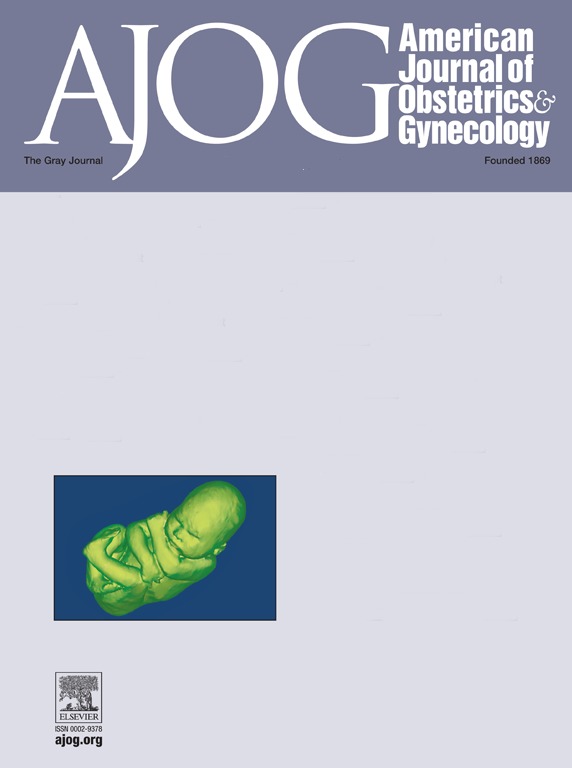提高生育可及性:2017-2021年单个学术中心雇主生育福利扩大的影响
IF 8.7
1区 医学
Q1 OBSTETRICS & GYNECOLOGY
引用次数: 0
摘要
世界卫生组织承认不孕症是一种疾病,它带来了情感和经济负担。体外受精(IVF)等治疗费用约为12,400美元(不包括药物),许多美国人可能会将其年收入的很大一部分分配给单个辅助生殖技术(ART)周期。为了减轻这一负担,少数州对生育治疗实行不同程度的保险覆盖。独立于州立法,个人雇主也可以提供生育福利。2019年,位于一个非强制性州的一家学术机构修改了其保险政策,开始提供高达2.5万美元的生育治疗。扩大覆盖面可以缓解财政压力,促进治疗可及性的多样性,因为数据表明,在不孕症治疗接受方面存在种族差异。目的:本研究分析了在单一机构实施扩大生育治疗保险福利前后寻求生育治疗的患者的人口结构变化和治疗利用情况。研究设计我们对2017年至2021年在一个大型城市学术医院系统的生殖诊所进行了回顾性图表回顾。分析包括描述性统计(均值、比例),实施前(2017-2018)和实施后(2019-2021)期间采用卡方检验、Fisher精确检验和Mann-Whitney U检验进行比较。结果2017- 2021年,新增生育服务患者1586例,其中生育福利扩大覆盖前(2017-2018年)378例,实施后(2019-2021年)1208例,比2017- 2021年增加162.9%。38-40岁患者求诊比例增加(12.4%比17.8%),老年患者求诊比例下降(41-42岁:9.3%比5.1%;年龄bbb42: 7.4% vs. 6.7%), < 38岁的患者比例无差异(p=0.01)。实施前后自我认同的种族/民族没有差异,患者最常被认为是非西班牙裔白人(41.5%对40.0%),紧随其后的是非西班牙裔黑人(38.6%对39.7%;p = 0.89)。实施后,没有不孕症的妇女寻求护理的比例更高(17.5% vs. 23.1%;P =0.03),特别是以卵母细胞冷冻保存(12.2%对16.7%)和孕前咨询(3.4%对5.6%;p = 0.02)。追求卵母细胞冷冻保存作为最高水平治疗的患者增加(5.8% vs 15.4%),但追求其他治疗的患者比例无差异(p<0.001)。患者首次预约前报告的不孕症也减少了(p<0.001)。结论在单一机构实施生育福利后,患者人口结构和生育治疗利用发生了变化,突出表明实施生育福利有可能改善医疗保健可及性,增强育龄妇女计划生育的权能。在患者自我报告的种族多样性方面没有观察到变化。然而,卵母细胞冷冻保存利用的显著增加以及没有生育问题的妇女参与计划生育方案,强调了生育效益在促进积极的生殖健康管理方面的重要性。本文章由计算机程序翻译,如有差异,请以英文原文为准。
Enhancing Reproductive Access: The Influence of Expanded Employer Fertility Benefits at a Single Academic Center from 2017-2021.
BACKGROUND
Recognized by the World Health Organization as a disease, infertility carries emotional and financial burdens. With treatments like in vitro fertilization (IVF) costing approximately $12,400 (not including medications), many Americans may allocate a substantial portion of their annual income to a single assisted reproductive technology (ART) cycle. To mitigate this burden, a minority of states mandate varying levels of insurance coverage for fertility treatment. Independent of state legislation, individual employers can also provide fertility benefits. In 2019, one academic institution, in a non-mandated state, amended its insurance policy to begin providing up to $25,000 of fertility treatment. Coverage expansion may ease financial stress and promote diversity in treatment access, as data indicates racial disparities in infertility treatment uptake.
OBJECTIVE
Our study analyzed demographic shifts and treatment utilization in patients seeking fertility treatment before and after implementation of an expanded fertility treatment insurance benefit at a single institution.
STUDY DESIGN
We conducted a retrospective chart review at a reproductive clinic in a large, urban academic hospital system from 2017 to 2021. Analyses included descriptive statistics (means, proportions) and pre-implementation (2017-2018) and post-implementation (2019-2021) periods were compared with chi-square tests, Fisher exact tests, and Mann-Whitney U tests.
RESULTS
From 2017 to 2021, 1,586 new patients accessed fertility services, including 378 prior to expanded fertility benefit coverage (2017-2018) and 1,208 after its implementation (2019-2021), representing a 162.9% increase from 2017 to 2021. There was an increase in the proportion of patients ages 38-40 years of age seeking care (12.4% vs. 17.8%), a decrease in the proportion of older patients (ages 41-42: 9.3% vs. 5.1%; age > 42: 7.4% vs. 6.7%), and no differences in the proportion of patients < 38 years (p=0.01). There were no differences in self-identified race/ethnicity before and after implementation, with patients most commonly identifying as non-Hispanic White (41.5% vs 40.0%), closely followed by non-Hispanic Black (38.6% vs 39.7%; p=0.89). After implementation, a higher proportion of women without infertility sought care (17.5% vs. 23.1%; p=0.03) specifically in the form of oocyte cryopreservation (12.2% vs 16.7%) and preconception counseling (3.4% vs 5.6%; p=0.02). There was an increase in patients pursuing oocyte cryopreservation as highest level of treatment (5.8% vs. 15.4%), but no differences in proportions of patients pursuing other treatment (p<0.001). Patient-reported infertility prior to first appointment also decreased (p<0.001).
CONCLUSIONS
Patient demographics and fertility treatment utilization changed after the adoption of fertility benefits at a single institution, highlighting that implementation of fertility benefits have potential to improve healthcare access and empower reproductively aged women in family planning. No changes were observed in the self-reported racial diversity of patients. However, the marked increase in oocyte cryopreservation utilization and the engagement of women without fertility issues in family planning options underscores the importance of fertility benefits in fostering proactive reproductive health management.
求助全文
通过发布文献求助,成功后即可免费获取论文全文。
去求助
来源期刊
CiteScore
15.90
自引率
7.10%
发文量
2237
审稿时长
47 days
期刊介绍:
The American Journal of Obstetrics and Gynecology, known as "The Gray Journal," covers the entire spectrum of Obstetrics and Gynecology. It aims to publish original research (clinical and translational), reviews, opinions, video clips, podcasts, and interviews that contribute to understanding health and disease and have the potential to impact the practice of women's healthcare.
Focus Areas:
Diagnosis, Treatment, Prediction, and Prevention: The journal focuses on research related to the diagnosis, treatment, prediction, and prevention of obstetrical and gynecological disorders.
Biology of Reproduction: AJOG publishes work on the biology of reproduction, including studies on reproductive physiology and mechanisms of obstetrical and gynecological diseases.
Content Types:
Original Research: Clinical and translational research articles.
Reviews: Comprehensive reviews providing insights into various aspects of obstetrics and gynecology.
Opinions: Perspectives and opinions on important topics in the field.
Multimedia Content: Video clips, podcasts, and interviews.
Peer Review Process:
All submissions undergo a rigorous peer review process to ensure quality and relevance to the field of obstetrics and gynecology.

 求助内容:
求助内容: 应助结果提醒方式:
应助结果提醒方式:


